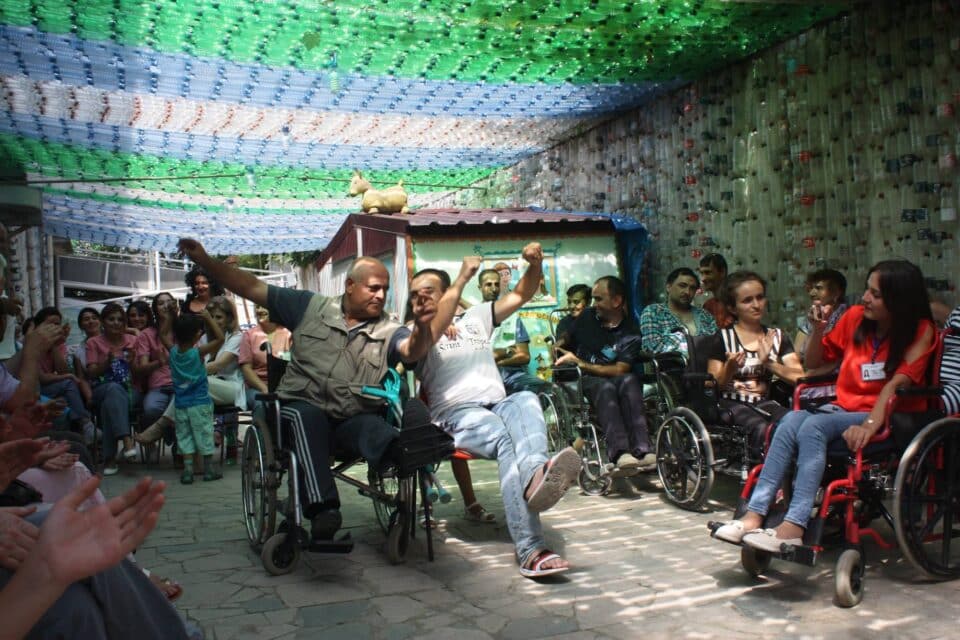Help our local partners realise their vision of hope for their communities

By Vardan Tadevosyan
The past thirty years have seen significant changes in the way we talk and think about disability. Since the early 1990s until now, Armenia has taken positive steps forward in tackling negative attitudes based on deep-rooted prejudice. Our language choices have become more inclusive. Our laws are up-to-date with international standards. This gives me hope.
However (and this is a big HOWEVER) we have a long way to go. People with disabilities remain Armenia’s most disadvantaged group. Society continues to put obstacles in their way – physical, institutional and attitudinal – which undermine their right to live independent, happy and fulfilling lives.
Here is a list of seven obstacles, followed by six suggestions:
1. Delayed or cancelled care: Good rehabilitation services exist in Armenia. But they are few and far between. Most services are not provided regularly and do not offer the full range of specialised treatments. Consider what this means for people who suffer from a stroke or traumatic brain injury. They require an intensive rehabilitation programme to achieve the highest possible level of functional recovery. If they only get small doses of therapy, delayed therapy, or no therapy at all, then they are much less likely to regain independence.
2. Institutionalisation: Dozens of facilities are not fit for purpose. Too many people are still being kept in long-stay institutions when the support they need should be delivered in the community. They are hidden from public life, subject to segregation or restraint. In some cases, they are confined to dirty rooms that are devoid of anything but a mattress on the floor. Clearly, the law’s high standards have not been transformed into reality.
3. Access to education: Many schools are inaccessible for children with physical disabilities. Barriers range from blocked wheelchair ramps, to buildings without lifts, to inaccessible toilets, to classrooms without step-free access. Students are also held back by un-tailored learning materials and lack of access to assistive devices. It breaks my heart because inaccessibility can affect a child’s ability to make friends, their reading and writing skills, and future prospects of finding employment.
4. Access to cultural venues: Similar problems are encountered in sport and leisure facilities, museums, public transport and built infrastructure, including court buildings and polling stations, which lack basic physical accessibility standards. What message does this send to people who may already feel marginalised by society?
5. Poor living standards: A large portion of Armenia’s affordable housing stock is in a bad condition. Common issues include: deficient insulation; broken gas, water and sewerage systems; unhygienic kitchens; and precarious environments for people with disabilities, such as multi-story living, no lifts or ramps, narrow doorways and inaccessible bathrooms.
6. Stigma and social exclusion: Throughout the former Soviet bloc, people with disabilities suffered discrimination, poverty and social exclusion. They were dismissed as ‘invalids’ and frequently side-lined from public life. I’ve witnessed over three decades that progress in this area has been made. Yet stigma remains. It creates barriers to participation in all areas of life.
7. Additional obstacles for refugees: Over 100,000 people (including me) recently sought refuge in Armenia following the ethnic cleansing of our homeland, Nagorno Karabakh. As many as 9,000 people with disabilities are among the displaced, most of whom are registered as service users of the Lady Cox Rehabilitation Centre. Patients can no longer visit the Centre. Many are traumatised and in urgent need of psychological support. They can barely afford food and rent, let alone “luxuries” like catheters, dressing materials, medical linens and adult nappies.
A report, published today by HART, sums up these challenges. It says: “A significant gap exists between the need for holistic care and the number of services available to meet this need. Many persons with disabilities continue to encounter significant barriers. There is limited access to high-quality care.”
The report makes a number of suggestions, aimed at the Government of Armenia, with a special emphasis on support for the staff and patients of the Lady Cox Rehabilitation Centre. I’m grateful because it is exactly the kind of help we need!
Here are the recommendations:
A. Support the re-establishment of the Centre with a sufficient budget to ensure long-term operational development.
B. Consult and actively involve staff and service users of the Centre in the implementation and monitoring of emergency relief for persons with disabilities.
C. Provide refugees from Nagorno Karabakh with an adequate standard of living and full access to basic services – with additional support for persons with disabilities, including access to information, support networks and assistive devices.
D. Accelerate efforts to close or reform long-stay institutions that segregate persons with disabilities from their communities.
E. Prioritise the development of community-based services, such as the Centre’s Home Visits project, which offer flexible and personal assistance.
F. Establish monitoring mechanisms with the involvement of persons with disabilities to improve accessibility standards in public spaces, homes and schools.
None of these are quick-fix solutions. There are no short-cuts to disability equality. They are nevertheless positive next steps, which should be championed by our Government, our Human Rights Ombudsman, our international partners, and all who strive for a fairer and more equal Armenia.
Vardan Tadevosyan is one of Armenia’s most experienced rehabilitation therapists for children and adults with disabilities. He is the Founder & Director of the Lady Cox Rehabilitation Centre.